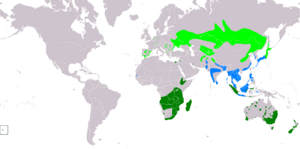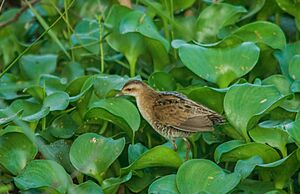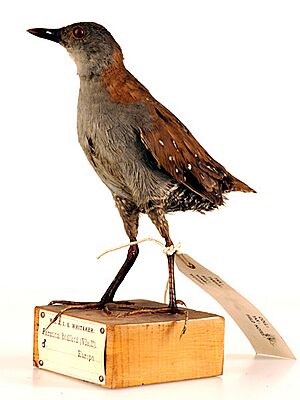Baillon's crake facts for kids
Quick facts for kids Baillon's crake |
|
|---|---|
 |
|
| Conservation status | |
| Scientific classification | |
 |
|
| Range of Z. pusilla Breeding Resident Non-breeding | |
| Synonyms | |
|
Porzana pusilla |
The Baillon's crake (Zapornia pusilla) is a very small waterbird. It is also known as the marsh crake. This bird belongs to the Rallidae family, which includes rails and coots.
Contents
Where Do Baillon's Crakes Live?
Homes and Migrations
These birds like to nest in wet areas with tall grass, called sedge beds. You can find them breeding in Europe, especially in the east, and across a large part of Asia and Europe called the Palearctic.
They used to live in Great Britain until the mid-1800s. But their numbers went down in western Europe because their wet homes were drained.
Good news! Their numbers have been growing again in north-western Europe. They have returned to Germany and the Netherlands. People even think they might be breeding in Britain again. In 2012, a Baillon's crake was seen in Ireland. It was the first time since the 1850s!
Baillon's crakes build their nests in dry spots within wet sedge bogs. They usually lay 4 to 8 eggs.
Traveling for Winter
Many Baillon's crakes are migratory birds. This means they travel long distances. They fly to east Africa and south Asia for the winter.
Some Baillon's crakes live in Africa and Australasia all year round. They do not migrate from these areas.
There has only been one time a Baillon's crake was seen in North America. This happened on Attu Island in September 2000.
Different Types of Baillon's Crakes
There are at least five different types, or subspecies, of Baillon's crake:
- The Marsh crake (Porzana pusilla affinis) lives in New Zealand.
- Porzana pusilla palustris lives in Australia and New Guinea.
- Porzana pusilla mira lives in Borneo.
- Porzana pusilla intermedia lives in Africa.
- Porzana pusilla pusilla lives in Asia and other places.
What Do Baillon's Crakes Look Like?
Baillon's crakes are small birds, about 16 to 18 centimeters (6 to 7 inches) long. They are similar to the little crake, which is only a bit bigger.
They have a short, straight beak that is yellow or green. It does not have a red base. Adult crakes have mostly brown feathers on their upper body. They also have some white markings. Their face and underparts are a blue-grey color. The feathers on their rear sides have black and white stripes.
Baillon's crakes have green legs with long toes. They also have a short tail with stripes underneath.
Young Baillon's crakes look a lot like the adults. But their underparts have more stripes. When they are very young, called downy chicks, they are completely black. This is true for all rail chicks.
How Do Baillon's Crakes Behave?
Finding Food
These birds use their beaks to search for food in mud or shallow water. They also pick up food they can see. Their main diet includes insects and small animals that live in water.
Secretive Birds
Baillon's crakes are very shy during their breeding season. You are more likely to hear them than to see them. They are noisy birds at this time. They make a rattling call that sounds like an edible frog or perhaps a garganey duck.
It can be easier to spot them when they are migrating or spending the winter in warmer places.
About Their Name
This bird is named after a French scientist named Louis Antoine Francois Baillon. The names marsh crake and tiny crake have also been used for this bird. The word pusillus comes from Latin and means "very small."
How Are Baillon's Crakes Protected?
Around the World
The Baillon's crake is one of the birds protected by the Agreement on the Conservation of African-Eurasian Migratory Waterbirds (AEWA). This agreement helps protect birds that travel between Africa and Eurasia.
In Australia
In Australia, the Baillon's crake is not listed as a threatened species under the national Environment Protection and Biodiversity Conservation Act 1999. However, how they are protected can be different in each state.
For example, in the state of Victoria, Baillon's crake is listed as threatened on the Flora and Fauna Guarantee Act (1988). It is also listed as vulnerable on Victoria's 2007 advisory list of threatened animals.




